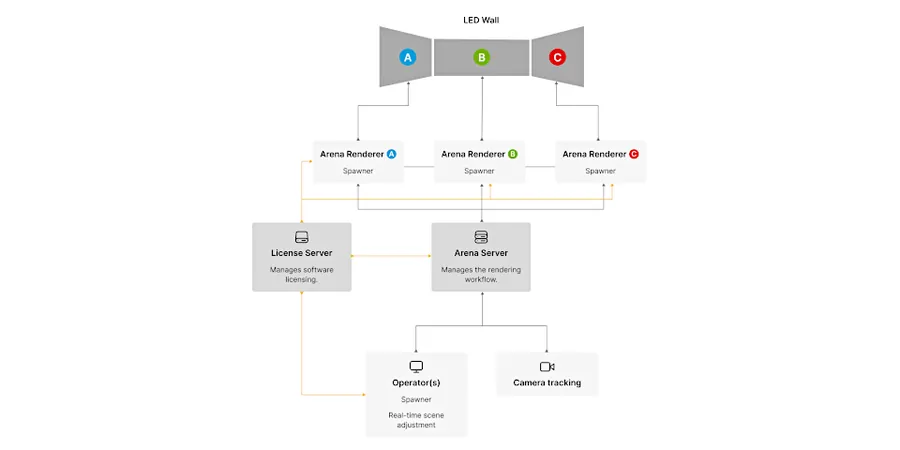
Unleashing Creativity: Chaos Arena Revolutionizes Virtual Production
2025-03-31
Author: Emma
Chaos Arena Launch
Chaos has officially launched Chaos Arena, a groundbreaking real-time solution that enhances in-camera visual effects (ICVFX) for virtual productions. This innovative technology is designed to help studios streamline their workflow by allowing them to display assets on LED walls using Chaos’s renowned V-Ray renderer without any preprocessing.
Redefining Virtual Production
In a bold move to disrupt the industry, Chaos promotes Arena as a "faster, simpler alternative to game engines" in the realm of virtual production. This tool enables users to effortlessly re-use assets originally created for offline rendering in V-Ray for real-time display, thus creating stunning virtual backdrops for previsualization (previs) or in-camera visual effects.
Technological Advancements
Originally unveiled as Project Arena, this technology aims to facilitate rapid adjustments in 3D scenes. With multiple operators able to make real-time changes based on feedback from directors or Directors of Photography (DoPs), Arena takes charge of coordinating these edits and synchronizing the rendering output to LED walls. Utilizing the same advanced core technology found in Chaos Vantage, the real-time ray tracing renderer known for exploring expansive V-Ray scenes, Arena is specifically engineered for distributed rendering across curved screens.
Path-Tracing Solution
Notably, Chaos Arena is touted as the "first-ever path-tracing solution for virtual shoots," which sets a new standard for quality in visual production.
Cutting-Edge Architecture and Compatibility
Chaos Arena employs a sophisticated server/spawner architecture that consists of a central server application connected to multiple spawner instances. These spawners manage both operator machines—feeding changes made in 3D scenes to the server—and rendering duties, with the server relaying instructions to render nodes. Additionally, individual spawners can control different sections of the LED wall, offering flexibility and precision in production.
For those utilizing real-time camera tracking, Arena is compatible with popular network client protocols, including Vicon and OptiTrack motion capture systems, as well as stYpe and EZTrack tracking solutions, and the FreeD protocol.
A Game-Changer Against Unreal Engine
Chaos Arena represents a significant challenge to the dominance of Unreal Engine, which currently leads the virtual production landscape. While Unreal was initially available for free to smaller studios, Epic Games instituted pricing for larger studios in the past year. Chaos aims to lure users with the promise that they can leverage their pre-existing V-Ray assets in Arena without the tedious conversion processes typically necessary when preparing these assets for game engines.
According to Chaos, Arena "eliminates the need for scene stripping, asset conversion, or baking," allowing users to project V-Ray animations onto LED walls in roughly 10 minutes. This seamless workflow ensures that studios can use the same quality assets for both pre and post-production without sacrificing quality or going through lengthy reworks.
Acknowledging Limitations and System Requirements
While Chaos Arena is a giant leap forward, it does come with some limitations. Although it can use standard .vrscene files exported from V-Ray, not all features of the .vrscene format are supported. For instance, Arena currently doesn't accommodate all advanced light and camera properties from Maya or all V-Ray material features.
Creators should also be aware of certain restrictions when utilizing Arena in production; for instance, there's a cap of 10 layers in blended materials and limitations on maximum texture resolutions.
For optimal performance, Chaos Arena is compatible with Windows 10 and requires a DXR-capable NVIDIA RTX GPU, excluding AMD or Intel processors from its current support. The pricing for the software is available on demand.
Conclusion
In conclusion, Chaos Arena is set to revolutionize the way virtual productions are handled, making it simpler than ever to create breathtaking visual effects at lightning speed. With features designed to respond dynamically to creative impulses and an architecture primed for the future of filmmaking, Chaos could very well reshape the landscape of digital cinema.









 Brasil (PT)
Brasil (PT)
 Canada (EN)
Canada (EN)
 Chile (ES)
Chile (ES)
 Česko (CS)
Česko (CS)
 대한민국 (KO)
대한민국 (KO)
 España (ES)
España (ES)
 France (FR)
France (FR)
 Hong Kong (EN)
Hong Kong (EN)
 Italia (IT)
Italia (IT)
 日本 (JA)
日本 (JA)
 Magyarország (HU)
Magyarország (HU)
 Norge (NO)
Norge (NO)
 Polska (PL)
Polska (PL)
 Schweiz (DE)
Schweiz (DE)
 Singapore (EN)
Singapore (EN)
 Sverige (SV)
Sverige (SV)
 Suomi (FI)
Suomi (FI)
 Türkiye (TR)
Türkiye (TR)
 الإمارات العربية المتحدة (AR)
الإمارات العربية المتحدة (AR)